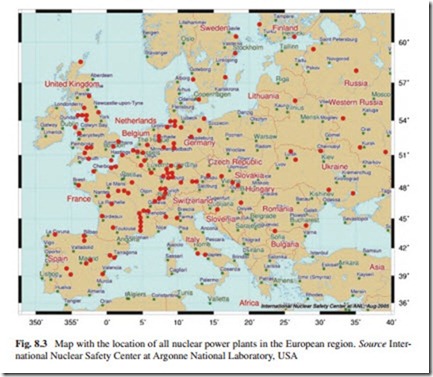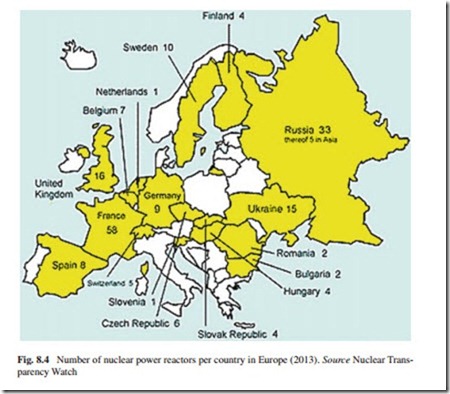Nuclear Power Plant Construction Plans
Most reactors currently planned are in the Asian region, with fast-growing economies and rapidly rising electricity demand. Many countries with existing nuclear power programs (Argentina, Armenia, Brazil, Bulgaria, Canada, China, Czech Republic, France, India, Pakistan, Romania, Russia, Slovakia, South Korea, South Africa, Ukraine, UK, and the USA) have plans to build new power reactors (beyond those now under construction). Some of the new nuclear power reactors are the following:
• In the USA, five units are under construction and there are plans for 13 new nuclear power reactors, while five more are under review. It is expected that some of the new units will be on line by 2020;
• In Finland, construction is now under way on a fifth, very large reactor, which
will come on line not before 2018, and plans are firming for another large one to follow it4;
• France is building a similar 1,600 MWe unit at Flamanville, for operation from 2016, and a second may follow it at Penly;
• In the UK, there are no nuclear power reactors under construction, but four 1,600 MWe units are planned for operation by 2019, and a further 6,000 MWe is proposed;
• Romania’s second power reactor is started up in 2007, and plans are being implemented for two further Canadian units to operate by 2017, but the beginning of the construction of these two units is not reported yet;
• Slovakia is completing two 470 MWe units at Mochovce to operate from 2014;
• Bulgaria is planning to build a large new nuclear power reactor at Kozloduy, but the beginning of construction of the new plant has not been reported yet;
• Belarus is planning two large new Russian nuclear power reactors at Ostrovets, the first to start in 2019;
• In Russia, ten new nuclear power reactors are under active construction, one being a large fast breeder neutron reactor. About 14 further units are planned, some to replace existing nuclear power reactors, and by 2017 ten new units totaling at least 9.2 GWe should be operating. Further nuclear power reactors up to 21 are planned to add new capacity in the future. A small floating power plant is expected to be completed by 2015 and others are planned to follow;
• Poland is planning two 3,000 MWe nuclear power plants, but the beginning of the construction of these units has not reported yet;
• South Korea has five nuclear power reactors under construction, and another five units are planned by 2021, giving a total new capacity of 12,200 MWe;
• China, now with 15 operating nuclear power reactors on the mainland, has the most ambitious nuclear power program in the world. Some 27 units are under construc- tion and many more are likely to be so in the coming years. China aims are at least to quadruple its nuclear capacity from that operating and under construction by 2020. In Taiwan, TAIPOWER is building two advanced reactors (ABWR) at Lungmen;
• India has 20 reactors in operation and six under construction. Twenty further units are planned and proposals for more—including Western and Russian designs—are taking shape following the lifting of trade restrictions;
• Pakistan has third and fourth 300 MWe reactors under construction at Chashma, financed by China. There are plans for more Chinese nuclear power reactors to be built in the coming years;
• In Kazakhstan, a joint venture with Russia’s ATOMSTROYEXPORT envisages development and marketing of innovative small and medium-sized reactors, starting with a 300 MWe Russian design as baseline for Kazakh units. However, there is no report about the beginning of the construction of any of these units;
• In Iran, nuclear power plant construction was suspended in 1979, but in 1995 Iran signed an agreement with Russia to complete a 1,000 MWe PWR at Bushehr. This started up in 2011 and was grid connected in August of that year. The coun- try is thinking to build a second nuclear power reactor in the coming years;
• The United Arab Emirates has awarded a $20.4 billion contract to a South Korean consortium to build four 1,400 MWe reactors by 2020;
• Jordan has committed plans for its first reactor to be operating by 2020 and is developing its legal and regulatory infrastructure. Now, the country reported the beginning of two more units, increasing to three the total units under construction;
• Turkey has contracts signed for four 1,200 MWe Russian nuclear reactors at one site and is negotiating similar capacity at another site. Until 2014, the beginning of the construction of the first unit has not been reported yet;
• Vietnam has committed plans for its first two units (2,000 MWe), to be operating by 2020. Until 2014, the beginning of the construction of the first unit has not been reported yet;
• Japan has two units reported under construction, but the future of these units is not yet clear as a result of the decision of the government to reduce the participation of nuclear energy in the country’s energy mix;
• Argentina has one unit under construction. It is expected that this unit can be connected to the grid before the end of 2015;
• Brazil has one unit under construction.
At the same time, other European countries are thinking to restart the use of nuclear energy for electricity generation in the coming years or are dropping pre- vious plans to close all of their nuclear power plants in operation. Belgium’s intention to start phasing out nuclear power in 2015 has run up against a finding, by the Federal Planning Bureau, that nuclear power is the best way for the country to meet its Kyoto Protocol commitments. Germany and Sweden wish to gradually phase out all nuclear plants for safety reasons, and generate electricity from renewable sources instead, but both governments are under strong pressure from the private energy industry not to go-ahead with their phase-out plans.
The three Baltic States, together with Poland, have agreed, in principle, to construct a nuclear power plant in Lithuania by 2015, and the country passed the necessary leg- islation in 2007 to make the construction of this plant possible (McDonald 2008).
Until today, only three EU’s countries have laws in force prohibiting the construction of nuclear power plants for electricity generation. These countries are Austria, Denmark, and Ireland. There is no indication that these three countries are going to change their policy regarding the use of nuclear energy for electricity generation in the future.
The map with the location of all nuclear power plants in the European region is shown in Figs. 8.3 and 8.4.

